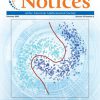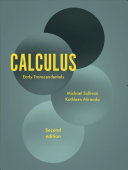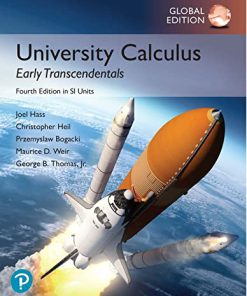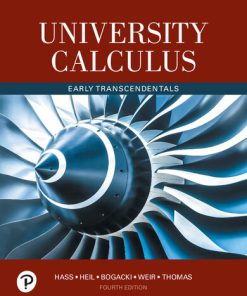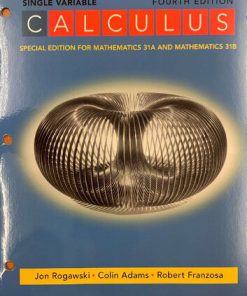Multivariable Calculus Early Transcendentals 4th Edition by Jon Rogawski, Colin Adams, Robert Franzosa ISBN 9781319055905 1319055907
$50.00 Original price was: $50.00.$25.00Current price is: $25.00.
Multivariable Calculus Early Transcendentals 4th Edition by Jon Rogawski, Colin Adams, Robert Franzosa – Ebook PDF Instant Download/Delivery: 9781319055905 ,1319055907
Full download Multivariable Calculus Early Transcendentals 4th Edition after payment
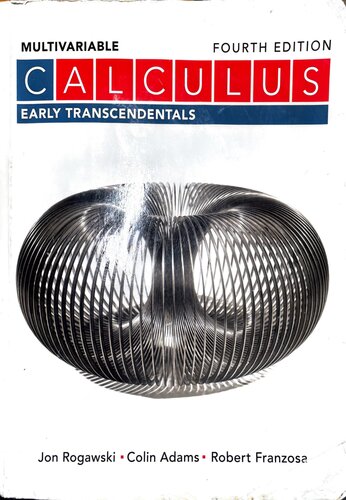
Product details:
ISBN 10: 1319055907
ISBN 13: 9781319055905
Author: Jon Rogawski, Colin Adams, Robert Franzosa
Multivariable Calculus Early Transcendentals 4th Edition Table of contents:
Chapter 1: Precalculus Review
1.1 Real Numbers, Functions, and Graphs
Graphing
Mathematical Models
1.1 Summary
1.1 Exercises
1.2 Linear and Quadratic Functions
1.2 Summary
1.2 Exercises
1.3 The Basic Classes of Functions
Constructing New Functions
Elementary Functions
Piecewise-Defined Functions
1.3 Summary
1.3 Exercises
1.4 Trigonometric Functions
Trigonometric Identities
1.4 Summary
1.4 Exercises
1.5 Inverse Functions
Inverse Trigonometric Functions
1.5 Summary
1.5 Exercises
1.6 Exponential and Logarithmic Functions
The Number e
Logarithms
Hyperbolic Functions
Inverse Hyperbolic Functions
Einstein’s Law of Velocity Addition
1.6 Summary
1.6 Exercises
1.7 Technology: Calculators and Computers
1.7 Summary
1.7 Exercises
Chapter Review Exercises
Chapter 2: Limits
2.1 The Limit Idea: Instantaneous Velocity and Tangent Lines
2.1 Summary
2.1 Exercises
2.2 Investigating Limits
Definition of a Limit
Graphical and Numerical Investigation
One-Sided Limits
Infinite Limits
2.2 Summary
2.2 Exercises
2.3 Basic Limit Laws
2.3 Summary
2.3 Exercises
2.4 Limits and Continuity
Examples of Discontinuities
Building Continuous Functions
Substitution: Evaluating Limits Using Continuity
2.4 Summary
2.4 Exercises
2.5 Indeterminate Forms
2.5 Summary
2.5 Exercises
2.6 The Squeeze Theorem and Trigonometric Limits
The Squeeze Theorem
2.6 Summary
2.6 Exercises
2.7 Limits at Infinity
2.7 Summary
2.7 Exercises
2.8 The Intermediate Value Theorem
2.8 Summary
2.8 Exercises
2.9 The Formal Definition of a Limit
The Size of the Gap
Proving Limit Theorems
2.9 Summary
2.9 Exercises
Chapter Review Exercises
Chapter 3: Differentiation
3.1 Definition of the Derivative
Estimating the Derivative
3.1 Summary
3.1 Exercises
3.2 The Derivative as a Function
Leibniz Notation
The Derivative and Behavior of the Graph
The Derivative of f(x) = ex
Differentiability, Continuity, and Local Linearity
3.2 Summary
3.2 Exercises
3.3 Product and Quotient Rules
3.3 Summary
3.3 Exercises
3.4 Rates of Change
Marginal Cost in Economics
Linear Motion
Motion Under the Influence of Gravity
3.4 Summary
3.4 Exercises
3.5 Higher Derivatives
3.5 Summary
3.5 Exercises
3.6 Trigonometric Functions
3.6 Summary
3.6 Exercises
3.7 The Chain Rule
3.7 Summary
3.7 Exercises
3.8 Implicit Differentiation
Derivatives of Inverse Trigonometric Functions
Finding Higher Order Derivatives Implicitly
3.8 Summary
3.8 Exercises
3.9 Derivatives of General Exponential and Logarithmic Functions
The Derivative of f(x) = bx and f(x) = logb x
Logarithmic Differentiation
Derivatives of Hyperbolic Functions
Inverse Hyperbolic Functions
3.9 Summary
3.9 Exercises
3.10 Related Rates
3.10 Summary
3.10 Exercises
Chapter Review Exercises
Chapter 4: Applications of the Derivative
4.1 Linear Approximation and Applications
Linear Approximation
Linearization
Differential Form of Linear Approximation
The Size of the Error
4.1 Summary
4.1 Exercises
4.2 Extreme Values
Local Extrema and Critical Points
Optimizing on a Closed Interval
Rolle’s Theorem
4.2 Summary
4.2 Exercises
4.3 The Mean Value Theorem and Monotonicity
Increasing / Decreasing Behavior of Functions
Testing Critical Points
4.3 Summary
4.3 Exercises
4.4 The Second Derivative and Concavity
Second Derivative Test for Critical Points
4.4 Summary
4.4 Exercises
4.5 L’Hôpital’s Rule
Comparing Growth of Functions
Proof of L’Hôpital’s Rule
4.5 Summary
4.5 Exercises
4.6 Analyzing and Sketching Graphs of Functions
4.6 Summary
4.6 Exercises
4.7 Applied Optimization
Open Versus Closed Intervals
4.7 Summary
4.7 Exercises
4.8 Newton’s Method
How Many Iterations Are Required?
Which Root Does Newton’s Method Compute?
4.8 Summary
4.8 Exercises
Chapter Review Exercises
Chapter 5: Integration
5.1 Approximating and Computing Area
Approximating Area by Rectangles
Summation Notation
Computing Area as the Limit of Approximations
5.1 Summary
5.1 Exercises
5.2 The Definite Integral
The Definite Integral and Signed Area
Properties of the Definite Integral
5.2 Summary
5.2 Exercises
5.3 The Indefinite Integral
Integrals Involvingex
Differential Equations
5.3 Summary
5.3 Exercises
5.4 The Fundamental Theorem of Calculus, Part I
5.4 Summary
5.4 Exercises
5.5 The Fundamental Theorem of Calculus, Part II
5.5 Summary
5.5 Exercises
5.6 Net Change as the Integral of a Rate of Change
The Integral of Velocity
Total Versus Marginal Cost
5.6 Summary
5.6 Exercises
5.7 The Substitution Method
Substitution Using Differentials
Change of Variables Formula for Definite Integrals
5.7 Summary
5.7 Exercises
5.8 Further Integral Formulas
Integrals Involving
5.8 Summary
5.8 Exercises
Chapter Review Exercises
Chapter 6: Applications of the Integral
6.1 Area Between Two Curves
Integration Along the y-Axis
6.1 Summary
6.1 Exercises
6.2 Setting Up Integrals: Volume, Density, Average Value
Volume
Density
Flow Rate
Average Value
6.2 Summary
6.2 Exercises
6.3 Volumes of Revolution: Disks and Washers
6.3 Summary
6.3 Exercises
6.4 Volumes of Revolution: Cylindrical Shells
6.4 Summary
6.4 Exercises
6.5 Work and Energy
6.5 Summary
6.5 Exercises
Chapter Review Exercises
Chapter 7: Techniques of Integration
7.1 Integration by Parts
7.1 Summary
7.1 Exercises
7.2 Trigonometric Integrals
7.2 Summary
7.2 Exercises
7.3 Trigonometric Substitution
7.3 Summary
7.3 Exercises
7.4 Integrals Involving Hyperbolic and Inverse Hyperbolic Functions
7.4 Summary
7.4 Exercises
7.5 The Method of Partial Fractions
Quadratic Factors
Using a Computer Algebra System
7.5 Summary
7.5 Exercises
7.6 Strategies for Integration
7.6 Summary
7.6 Exercises
7.7 Improper Integrals
Unbounded Functions
Comparing Integrals
7.7 Summary
7.7 Exercises
7.8 Numerical Integration
The Midpoint Rule
The Trapezoidal Rule
Error Bounds
Simpson’s Rule
7.8 Summary
7.8 Exercises
Chapter Review Exercises
Chapter 8: Further Applications Of The Integral
8.1 Probability and Integration
8.1 Summary
8.1 Exercises
8.2 Arc Length and Surface Area
Surface Area
8.2 Summary
8.2 Exercises
8.3 Fluid Pressure and Force
8.3 Summary
8.3 Exercises
8.4 Center of Mass
Laminas (Thin Plates)
Historical Perspective
8.4 Summary
8.4 Exercises
Chapter Review Exercises
Chapter 9: Introduction to Differential Equations
9.1 Solving Differential Equations
Separation of Variables
Exponential Growth and Decay
9.1 Summary
9.1 Exercises
9.2 Models Involving y′ = k(y − b)
9.2 Summary
9.2 Exercises
9.3 Graphical and Numerical Methods
9.3 Euler’s Method
9.3 Summary
9.3 Exercises
9.4 The Logistic Equation
9.4 Summary
9.4 Exercises
9.5 First-Order Linear Equations
9.5 Summary
9.5 Exercises
Chapter Review Exercises
Chapter 10: Infinite Series
10.1 Sequences
10.1 Summary
10.1 Exercises
10.2 Summing an Infinite Series
10.2 Summary
10.2 Exercises
10.3 Convergence of Series with Positive Terms
10.3 Summary
10.3 Exercises
10.4 Absolute and Conditional Convergence
10.4 Summary
10.4 Exercises
10.5 The Ratio and Root Tests and Strategies for Choosing Tests
Determining Which Test to Apply
10.5 Summary
10.5 Exercises
10.6 Power Series
Power Series Solutions of Differential Equations
10.6 Summary
10.6 Exercises
10.7 Taylor Polynomials
The Error Bound
10.7 Summary
10.7 Exercises
10.8 Taylor Series
Shortcuts to Finding Taylor Series
Binomial Series
Euler’s Formulas
10.8 Summary
10.8 Exercises
Chapter Review Exercises
Chapter 11: Parametric Equations, Polar Coordinates, and Conic Sections
11.1 Parametric Equations
Tangent Lines to Parametric Curves
Area Under a Parametric Curve
11.1 Summary
11.1 Exercises
11.2 Arc Length and Speed
11.2 Summary
11.2 Exercises
11.3 Polar Coordinates
11.3 Summary
11.3 Exercises
11.4 Area and Arc Length in Polar Coordinates
11.4 Summary
11.4 Exercises
11.5 Conic Sections
Eccentricity
Reflective Properties of Conic Sections
General Equations of Degree 2
11.5 Summary
11.5 Exercises
Chapter Review Exercises
Chapter 12: Vector Geometry
12.1 Vectors in the Plane
Vector Algebra
12.1 Summary
12.1 Exercises
12.2 Three-Dimensional Space: Surfaces, Vectors, and Curves
Surfaces
Vectors in 3-Space
Curves and Lines
12.2 Summary
12.2 Exercises
12.3 Dot Product and the Angle Between two Vectors
12.3 Summary
12.3 Exercises
12.4 The Cross Product
Cross Products, Area, and Volume
Proofs of Cross-Product Properties
12.4 Summary
12.4 Exercises
12.5 Planes in 3-Space
12.5 Summary
12.5 Exercises
12.6 A Survey of Quadric Surfaces
12.6 Summary
12.6 Exercises
12.7 Cylindrical and Spherical Coordinates
Cylindrical Coordinates
Spherical Coordinates
12.7 Summary
12.7 Exercises
Chapter Review Exercises
Chapter 13: Calculus Of Vector-Valued Functions
13.1 Vector-Valued Functions
13.1 Summary
13.1 Exercises
13.2 Calculus of Vector-Valued Functions
The Derivative as a Tangent Vector
Vector-Valued Integration
13.2 Summary
13.2 Exercises
13.3 Arc Length and Speed
Arc Length Parametrization
13.3 Summary
13.3 Exercises
13.4 Curvature
The Normal Vector
The Frenet Frame
Plane and Circle
13.4 Summary
13.4 Exercises
13.5 Motion in 3-Space
Understanding the Acceleration Vector
13.5 Summary
13.5 Exercises
13.6 Planetary Motion According to Kepler and Newton
Kepler’s Second Law
Proof of the Law of Ellipses
13.6 Summary
13.6 Exercises
Chapter Review Exercises
Chapter 14: Differentiation in Several Variables
14.1 Functions of Two or More Variables
Graphing Functions of Two Variables
Traces
Level Curves and Contour Maps
More Than Two Variables
14.1 Summary
14.1 Exercises
14.2 Limits and Continuity in Several Variables
14.2 Summary
14.2 Exercises
14.3 Partial Derivatives
Higher Order Partial Derivatives
14.3 Summary
14.3 Exercises
14.4 Differentiability, Tangent Planes, and Linear Approximation
Assumptions Matter
14.4 Summary
14.4 Exercises
14.5 The Gradient and Directional Derivatives
Introduction to the Chain Rule for Paths
Directional Derivatives
Properties of the Gradient
14.5 Summary
14.5 Exercises
14.6 Multivariable Calculus Chain Rules
Implicit Differentiation
14.6 Summary
14.6 Exercises
14.7 Optimization in Several Variables
Global Extrema
14.7 Summary
14.7 Exercises
14.8 Lagrange Multipliers: Optimizing with a Constraint
14.8 Summary
14.8 Exercises
Chapter Review Exercises
Chapter 15: Multiple Integration
15.1 Integration in Two Variables
Iterated Integrals
15.1 Summary
15.1 Exercises
15.2 Double Integrals over More General Regions
Regions Between Two Graphs
Average Value
Decomposing the Domain into Smaller Domains
15.2 Summary
15.2 Exercises
15.3 Triple Integrals
The Volume of the Sphere in Higher Dimensions
15.3 Summary
15.3 Exercises
15.4 Integration in Polar, Cylindrical, and Spherical Coordinates
Double Integrals in Polar Coordinates
Triple Integrals in Cylindrical Coordinates
Triple Integrals in Spherical Coordinates
15.4 Summary
15.4 Exercises
15.5 Applications of Multiple Integrals
Probability Theory
15.5 Summary
15.5 Exercises
15.6 Change of Variables
Maps from R2 to R2
How Area Changes Under a Mapping: The Jacobian Determinant
The Change of Variables Formula
Change of Variables in Three Variables
15.6 Summary
15.6 Exercises
Chapter Review Exercises
Chapter 16: Line and Surface Integrals
16.1 Vector Fields
Operations on Vector Fields
Conservative Vector Fields
16.1 Summary
16.1 Exercises
16.2 Line Integrals
Scalar Line Integrals
Applications of the Scalar Line Integral
Vector Line Integrals
Applications of the Vector Line Integral
16.2 Summary
16.2 Exercises
16.3 Conservative Vector Fields
Conservative Fields in Physics
Finding Potential Functions
The Vortex Field
16.3 Summary
16.3 Exercises
16.4 Parametrized Surfaces and Surface Integrals
Grid Curves, Normal Vectors, and the Tangent Plane
Surface Area
Surface Integral
Gravitational Potential of a Sphere
16.4 Summary
16.4 Exercises
16.5 Surface Integrals of Vector Fields
Fluid Flux
Electric and Magnetic Fields
Types of Integrals
16.5 Summary
16.5 Exercises
Chapter Review Exercises
Chapter 17: Fundamental Theorems of Vector Analysis
17.1 Green’s Theorem
Area via Green’s Theorem
The Circulation Form of Green’s Theorem
Additivity of Circulation
More General Form of Green’s Theorem
Flux Form of Green’s Theorem
17.1 Summary
17.1 Exercises
17.2 Stokes’ Theorem
17.2 Summary
17.2 Exercises
17.3 Divergence Theorem
Applications to Electrostatics
17.3 Summary
17.3 Exercises
Chapter Review Exercises
Appendices
A The Language of Mathematics
B Properties of Real Numbers
C Induction and The Binomial Theorem
D Additional Proofs
People also search for Multivariable Calculus Early Transcendentals 4th Edition:
james stewart multivariable calculus early transcendentals
multivariable calculus early transcendentals 8th edition by james stewart
multivariable calculus early transcendentals 8th edition
j.stewart single and multivariable calculus early transcendentals 2018
multivariable calculus early transcendentals 4th edition
Tags:
Jon Rogawski,Colin Adams,Robert Franzosa,Multivariable Calculus,Transcendentals
You may also like…
Mathematics - Applied Mathematics
University Calculus: Early Transcendentals in SI Units 4th Edition Joel R. Hass
Mathematics - Mathematical Foundations
Mathematics - Computational Mathematics
Mathematics - Computational Mathematics
Uncategorized
Mathematics Mathematics - Mathematical Foundations
Calculus Late Transcendentals Single Variable 4th Edition Jon Rogawski


